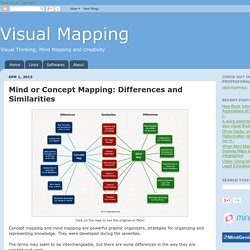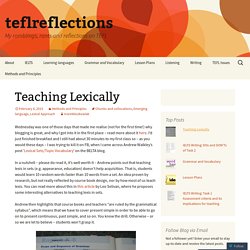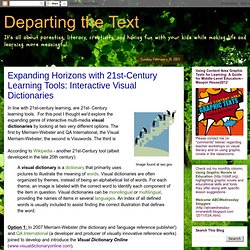

Doing It Differently: Tips for Teaching Vocabulary. Every Monday my seventh grade English teacher would have us copy a list of 25 words she'd written on the board.

We'd then look up the dictionary definitions and copy those down. For homework, we'd re-write each word seven times. Good, now you know it. Test on Friday and never for those 25 words to be seen again. Poof. Copying definitions from the dictionary we would probably all agree is not an effective way to learn vocabulary. The truth is, and the research shows, students need multiple and various exposures to a word before they fully understand that word and can apply it. Selecting Words Ah, so many words, so little time. My first year teaching, before my tenth graders began reading Lord of the Flies, I went through every chapter and made lists of all the vocabulary words I thought they'd have trouble with, so that I could pre-teach them.
When I looked at those long lists, I began to freak out. Then, here's what to do after the students pick their own words: Defining "Best Practice" in Teaching. It's often said in the teaching world (as in many professions and trades, I imagine), "Why reinvent the wheel when there are plenty of practices that already work?

" In their book, Professional Capital: Transforming Teaching in Every School, Andy Hargreaves and Michael Fullan share their definition for "best practices," which they define as existing practices that already possess a high level of widely-agreed effectiveness. We teachers are standing on the shoulders of giants before us who have developed tried-and-true strategies by testing them out, reflecting on the outcomes, and honing those strategies over decades or longer.
And they work; they get results. What are some of the best pedagogical practices I've adopted over the years from my mentors and guides in this field? Here are just a few straightforward ones that are known, and used, by many educators: Check for understanding often and in a variety of ways. The Role of Research "The Next" Best Thing. Doing It Differently: Tips for Teaching Vocabulary.
嬰幼兒預防接種與保健資訊簡訊系統. Mind or Concept Mapping: Differences and Similarities. Concept mapping and mind mapping are powerful graphic organizers, strategies for organizing and representing knowledge.

They were developed during the seventies. The terms may seem to be interchangeable, but there are some differences in the way they are created and used. On the map above we can see some key differences and similarities between these two techniques. In my Opinion, Concept Mapping is rather leveraging logical thinking while Mind Mapping improves the balance between creativity and logical thinking. Both techniques are complementary and help you to develop various skills such as identification of key concepts, pattern recognition, ideas organization, context understanding, etc... In the video below, Karen Rohrbauck Stout at Western Washington University explains how she uses concept mapping as an assessment technique. Response: Ten Principles for Vocabulary Instruction.
Teaching Lexically. Wednesday was one of those days that made me realise (not for the first time!)

Why blogging is great, and why I got into it in the first place – read more about it here. I’d just finished breakfast and I still had about 30 minutes to my first class so – as you would these days – I was trying to kill it on FB, when I came across Andrew Walkley’s post ‘Lexical Sets/Topic Vocabulary‘ on the BELTA blog. In a nutshell – please do read it, it’s well worth it – Andrew points out that teaching lexis in sets (e.g. appearance, education) doesn’t help acquisition. That is, students would learn 10 random words faster than 10 words from a set. An idea proven by research, but not really reflected by course book design, nor by how most of us teach lexis. You’ve got to have a system: vocabulary development in EFL. Julie Norton, a university lecturer and materials writer, considers the benefits of adopting a systematic approach to vocabulary development and suggests a checklist for evaluating the vocabulary included in teaching materials.

Takeaway Value All learners want to feel that they are making progress, so it is important for them to take away something at the end of each lesson. Learning new vocabulary is very motivating, particularly for adult learners, because they often feel they have learnt a great deal of grammar at school. Expanding Horizons with 21st-Century Learning Tools: Interactive Visual Dictionaries. In line with 21st-century learning, are 21st- Century learning tools.

For this post I thought we'd explore the expanding genre of interactive multi-media visual dictionaries by looking at two very different options. The first by Merriam-Webster and QA International, the Visual Merriam-Webster; the second is Visuwords. The third is According to Wikipedia - another 21st-Century tool (albeit developed in the late 20th century): A visual dictionary is a dictionary that primarily uses pictures to illustrate the meaning of words.
Option 1: In 2007 Merriam-Webster (the dictionary and 'language reference publisher') and QA International (a developer and producer of visually innovative reference works) joined to develop and introduce the Visual Dictionary Online (www.visualdictionaryonline.com). About WordNet - WordNet - About WordNet.